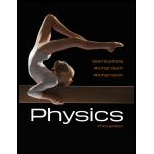
Concept explainers
(a)
Find the air pressure difference between the top and bottom of the Willis tower.
(a)
Answer to Problem 82P
The air pressure difference between the top and bottom of the Willis tower in Pascal is
Explanation of Solution
Write the equation for pressure difference.
Here,
Conclusion:
Substitute
Thus, the pressure difference between the top and bottom of the Willis tower in Pascal is
Convert pressure difference in atm.
Thus, the pressure difference between the top and bottom of the Willis tower in atmospheric condition is
(b)
Find the number of pressure decreases in Pa for every meter of altitude.
(b)
Answer to Problem 82P
The number of pressure decreases in Pa for every meter of altitude is
Explanation of Solution
Write the equation for pressure difference.
Here,
The number of Pa the pressure decreases for every meter of altitude is.
Conclusion:
Substitute
Therefore, the number of pressure decreases in Pa for every meter of altitude is
(c)
Find the altitude at which the atmospheric pressure reaches zero.
(c)
Answer to Problem 82P
The altitude at which the atmospheric pressure reaches zero is at
Explanation of Solution
Write the equation for pressure variation with depth.
Here,
If the object is kept on the atmosphere, suppose we take point 1 at the surface and point 2 is a depth, then
Substitute 0 for
Conclusion:
Substitute
Therefore, the altitude at which the atmospheric pressure reaches zero is at
(d)
Find the true or false statement
(d)
Answer to Problem 82P
The true statement, if the pressure is non-zero at a certain altitude and the atmosphere extends to a higher altitude.
Explanation of Solution
Since the zero altitude is calculated from an expression inverse proportionality to the air density, so that decreasing air density means that the atmospheric extends to a higher altitude.
Want to see more full solutions like this?
Chapter 9 Solutions
Student Solutions Manual for Physics
 College PhysicsPhysicsISBN:9781305952300Author:Raymond A. Serway, Chris VuillePublisher:Cengage Learning
College PhysicsPhysicsISBN:9781305952300Author:Raymond A. Serway, Chris VuillePublisher:Cengage Learning University Physics (14th Edition)PhysicsISBN:9780133969290Author:Hugh D. Young, Roger A. FreedmanPublisher:PEARSON
University Physics (14th Edition)PhysicsISBN:9780133969290Author:Hugh D. Young, Roger A. FreedmanPublisher:PEARSON Introduction To Quantum MechanicsPhysicsISBN:9781107189638Author:Griffiths, David J., Schroeter, Darrell F.Publisher:Cambridge University Press
Introduction To Quantum MechanicsPhysicsISBN:9781107189638Author:Griffiths, David J., Schroeter, Darrell F.Publisher:Cambridge University Press Physics for Scientists and EngineersPhysicsISBN:9781337553278Author:Raymond A. Serway, John W. JewettPublisher:Cengage Learning
Physics for Scientists and EngineersPhysicsISBN:9781337553278Author:Raymond A. Serway, John W. JewettPublisher:Cengage Learning Lecture- Tutorials for Introductory AstronomyPhysicsISBN:9780321820464Author:Edward E. Prather, Tim P. Slater, Jeff P. Adams, Gina BrissendenPublisher:Addison-Wesley
Lecture- Tutorials for Introductory AstronomyPhysicsISBN:9780321820464Author:Edward E. Prather, Tim P. Slater, Jeff P. Adams, Gina BrissendenPublisher:Addison-Wesley College Physics: A Strategic Approach (4th Editio...PhysicsISBN:9780134609034Author:Randall D. Knight (Professor Emeritus), Brian Jones, Stuart FieldPublisher:PEARSON
College Physics: A Strategic Approach (4th Editio...PhysicsISBN:9780134609034Author:Randall D. Knight (Professor Emeritus), Brian Jones, Stuart FieldPublisher:PEARSON





